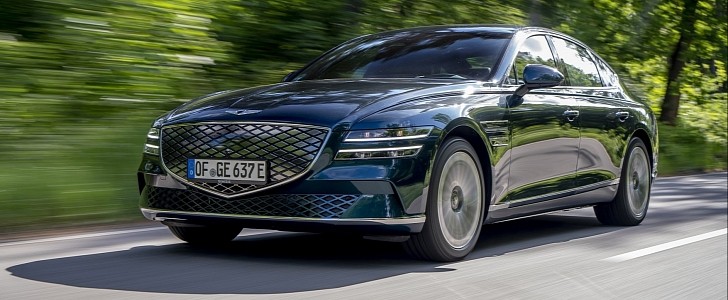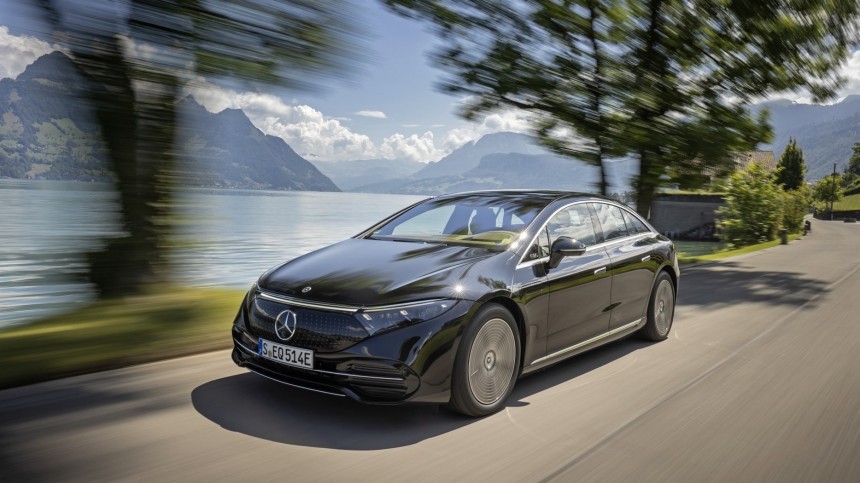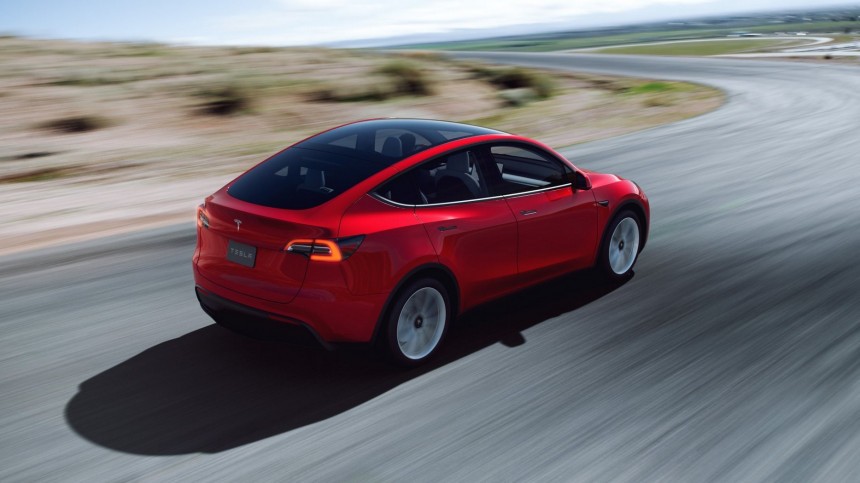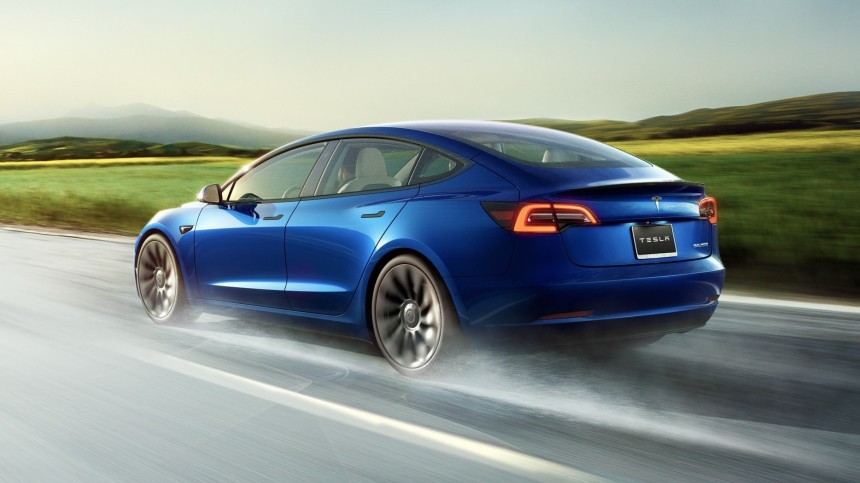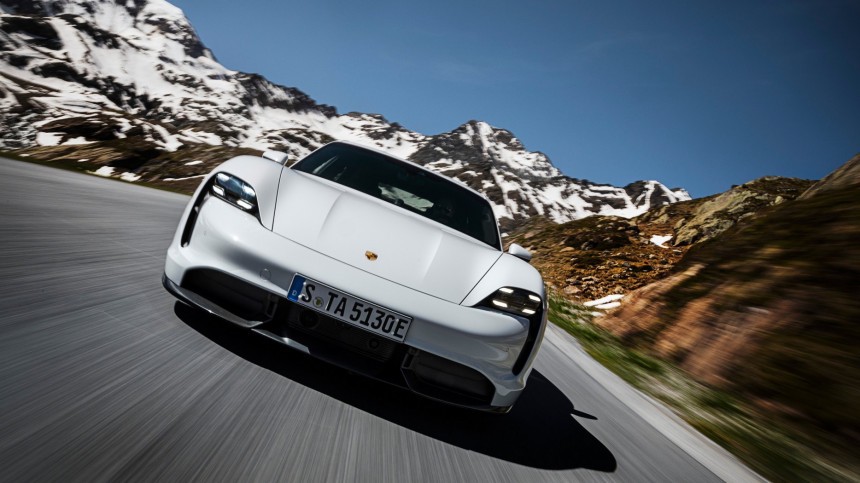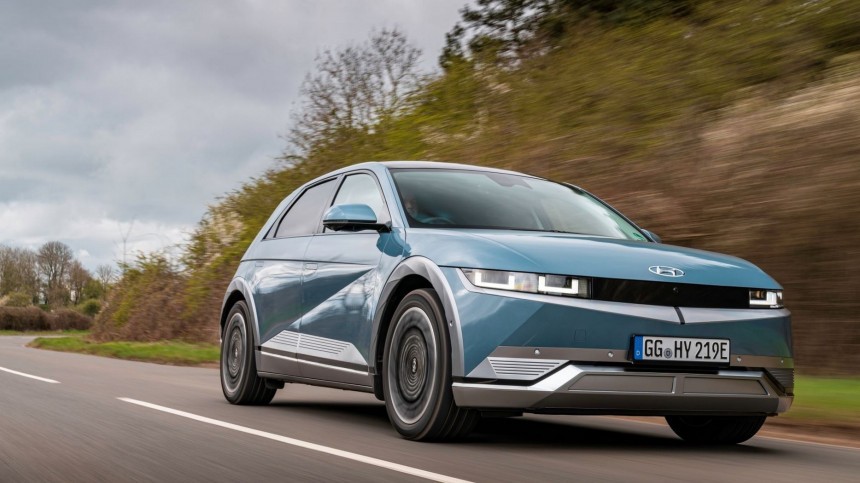Car magazines and a few websites have teams dedicated to testing vehicles on track, allowing them to verify automakers’ claims about their products. Sometimes, they seize multiple tests to create more content, which seems to be the case with what Auto Bild did with 36 electric cars. The German magazine presented their true range after running at 130 kph (81 mph) with a fully charged battery. Curiously, it did not explore how that compares with official WLTP figures, but we did.
It seems that Auto Bild often tests most EVs at 130 kph but never made a ranking with that information before this one. When it did, the Mercedes-Benz EQS 450+ was the car that offered more range at highway speeds with a full charge. The German magazine drove it for 482 kilometers (299.5 miles) at 130 kph before it stopped. While that sounds good in absolute terms, it is not that great when you think about the context. People who buy this car expecting it to be close to its official WLTP range of 785 km (487.8 mi) may feel disappointed.
The explanation for that is simple: the official range considers a combined test cycle. If the EQS drove only in the city at low speeds, it would travel further than these 785 km. While some carmakers release the numbers for urban, highway, and combined uses, most stick to a single figure. Porsche is among the exceptions: it states the long-distance range for the Taycan Turbo S is 360 km (223.7 mi), while the mixed cycle test number is 468 km (290.8 mi). You can check the ranking Auto Bild created in the table below. As you’ll notice, It also includes the loss percentages we have calculated:
The table shows that the world’s lowest drag coefficient production car still loses 38.6% of its expected range at highway speeds. A low drag coefficient should help a vehicle spend less energy fighting air resistance, which shows that the EQS may have other elements at play to make it appear in the worst half among the 36 electric Auto Bild tested at 130 kph. To be more specific, it is in the 20th position in the table below, which we organized according to the loss percentages we calculated. The lower the percentage, the better.
To make these calculations, we had to find out most of the WLTP ranges for these EVs. The German magazine only disclosed the range for a few of the EVs, which we also checked. We found some numbers on the carmakers’ websites. Surprisingly, some of them were different from the ones officially informed by the manufacturers. When that happened, we went with the official information.
We have no idea why local websites inform different figures. However, that is something anyone interested in these vehicles should have in mind – especially after we have seen how much variation these numbers can suffer at the same highway speed depending on the EV. Check our table below:
The car that lost less range compared to its WLTP number was the Genesis Electrified G80. From the official 520 km (323 mi) range, Auto Bild drove it for 427 km (265 mi) at 130 kph. That represented 17.9% of losses, which is still a 20% gap from what some buyers may expect it to travel.
That is an essential warning about electric vehicles. Being so efficient, they are also more sensitive to elements such as aerodynamics. The faster they go, the more air resistance they face. The little energy they would spend moving goes to beating this air resistance, which reduces range much more than it does in combustion-engined vehicles.
Ironically, the world’s most aerodynamic vehicle for sale nowadays presented a loss percentage more than twice that of the Electrified G80. Unlike the Mercedes-Benz EQS, the Genesis is based on an ICE platform, the Hyundai-Kia M3, which makes these results even more impressive.
As we mentioned before, there are other vital factors in achieving the most mileage for the energy you spend: mass and motor efficiency. Although these elements may have played a role in the EQS variation, we may also be facing something similar to what happens with EPA energy efficiency numbers.
Edmunds has demonstrated that some automakers – Tesla in particular – disclose energy consumption figures that are much better than the ones verified in real life. Of all the cars the American website evaluated, only those from Tesla and Polestar did not manage to beat their EPA numbers, which are also based on a combined test cycle. If Edmunds did a high-speed evaluation as Auto Bild did, no vehicle would beat its EPA numbers.
Despite that, Tesla’s tendency to overpromise was also evident with Auto Bild tests. The Tesla Model Y Long Range has an official WLTP range of 533 km (331 mi) but delivered only 304 km (188.9 mi), or 43% less than the official number suggests. If the EQS numbers were not good, this is even worse.
Auto Bild mentions a Model 3 in its story but does not clarify which derivative it tested. The picture shows a dual motor, suggesting a Long Range, but the text talks about a vehicle costing less than €50,000 (€49,990 on the company’s website, to be more precise). That’s equivalent to $50,967 at the current exchange rate.
If we were to believe the picture instead of the unclear text from Auto Bild, the Model 3 would also confirm that Tesla exaggerates with its WLTP numbers. The EV maker says the Model 3 Long Range Dual Motor achieves a WLTP range of 602 km. It costs €59,490 ($60,653) in Germany. Compared to that, the real-life range at 130 kph represents 39.7% in losses at highway speed.
If the Standard Range Plus is the vehicle Auto Bild evaluated, it has a WLTP range of 491 km (305.1 mi). In that case, the real-life range of 363 km (225.6 mi) corresponds to 26.1% less range than the WLTP cycle promises. Only Auto Bild can say for sure which comparison is the correct one.
There are other issues with the Auto Bild ranking. Curiously, the German magazine talks about the Model S, but it did not test it. The Hyundai Kona Electric appears in front of the Ford Mustang Mach-E GT and the Volkswagen ID.5 Pro Performance, even with an inferior real-life range: 336 km (208.8 mi). The same happened with the Mercedes-Benz EQA 250 (222 km, or 137.9 mi) and the Cupra Born (226 km, or 140.4 mi), which are in front of the Volvo XC40 P6 Recharge (227 km, or 141 mi) despite their lower ranges.
Constant updates also may have made the tests obsolete. Auto Bild said it tested two Hyundai IONIQ 5, one with a 160-kW rear motor and one with two motors delivering 225 kW. Their battery pack was the biggest one, offering 72.6 kWh of usable capacity. These vehicles are no longer for sale. The IONIQ 5 now offers 77.4 kWh and more potent motors: 168 kW on the RWD vehicle and 239 kW on the AWD derivative.
Although it has some issues, the Auto Bild story’s main asset is its test numbers. They show that the Cupra Born is the worst EV when you talk about highway speeds: from the 496 km (308.2 mi) a fully charged battery pack should give it, it delivers only 226 km (140.4 mi) at 130 kph. That’s 54.4% less than the official numbers. Perhaps that has to do with the urban profile the Born and the ID.3 have. The Born’s brother from another mother (Volkswagen) is the 34th among the 36 EVs Auto Bild tested.
On the other hand, two other siblings are among the best in Auto Bild’s high-speed testing: the Audi RS e-tron GT and the Porsche Taycan Turbo S, in this order. They are respectively the fifth and sixth best ones. That may have to do with the fact that the Taycan and the e-tron use two-speed transmissions.
Perhaps the Volkswagen Group developed the Audi and the Porsche to be more efficient at highway speeds and the ID.3 and Born to do better in urban cycles. There’s coherence with the numbers, as with the ID.4, Q4 e-tron, and Skoda Enyaq iV. That does not happen with the Hyundai Group.
While the Genesis GV60 is the seventh better EV in losses at highway speeds, the Kia EV6 is in 26th place. The IONIQ 5 is an even more mysterious case because it reveals disparities in a single model. The AWD derivative is in 23rd, which could suggest the RWD was in a better position. It isn’t: it is in 33rd place.
The numbers are fascinating and rich material for many more articles, but they demand extended interviews and a lot more work. This text alone already required four days of attention and research, so we’ll get back to the subject whenever we can further develop it. Meanwhile, feel free to explore the numbers and what they have allowed us to write so far.
The explanation for that is simple: the official range considers a combined test cycle. If the EQS drove only in the city at low speeds, it would travel further than these 785 km. While some carmakers release the numbers for urban, highway, and combined uses, most stick to a single figure. Porsche is among the exceptions: it states the long-distance range for the Taycan Turbo S is 360 km (223.7 mi), while the mixed cycle test number is 468 km (290.8 mi). You can check the ranking Auto Bild created in the table below. As you’ll notice, It also includes the loss percentages we have calculated:
| Ranking | EV | WLTP Range | Real-life Range | Losses |
| 1 | Mercedes-Benz EQS 450+ 4Matic | 785 | 482 | 38,6% |
| 2 | BMW iX xDrive50 | 630 | 434 | 31,1% |
| 3 | Genesis Electrified G80 | 520 | 427 | 17,9% |
| 4 | Mercedes-Benz EQE 350+ | 660 | 423 | 35,9% |
| 5 | Polestar 2 SM LR | 542 | 374 | 31,0% |
| 6 | Audi RS e-tron GT | 487 | 367 | 24,6% |
| 7 | Tesla Model 3 | 602 | 363 | 39,7% |
| 8 | VW ID.5 Pro Performance | 520 | 340 | 34,6% |
| 9 | Ford Mustang Mach-E GT | 610 | 337 | 44,8% |
| 10 | Porsche Taycan Turbo S | 468 | 336 | 28,2% |
| 11 | Hyundai Kona Electric | 484 | 336 | 30,6% |
| 12 | VW ID.4 GTX | 480 | 332 | 30,8% |
| 13 | Genesis GV60 Dual Motor Sport Plus | 466 | 330 | 29,2% |
| 14 | VW ID.4 Pro 77 kWh RWD | 520 | 328 | 36,9% |
| 15 | Audi Q4 e-tron 40 | 520 | 326 | 37,3% |
| 16 | Skoda Enyaq iV80 | 510 | 318 | 37,6% |
| 17 | Kia EV6 | 528 | 305 | 42,2% |
| 18 | Tesla Model Y Long Range Dual Motor | 533 | 304 | 43,0% |
| 19 | BMW i4 M50 | 510 | 299 | 41,4% |
| 20 | Renault Zoe E-Tech EV50 | 377 | 292 | 22,5% |
| 21 | Hyundai Ioniq 5 AWD 225 kW | 481 | 290 | 39,7% |
| 22 | Kia e-Soul 64 kWh | 452 | 280 | 38,1% |
| 23 | Mercedes-Benz EQV 300 | 349 | 273 | 21,8% |
| 24 | Renault Megane E-Tech EV60 220 | 470 | 268 | 43,0% |
| 25 | Hyundai Ioniq 5 160 kW | 507 | 261 | 48,5% |
| 26 | Polestar 2 DM LR | 482 | 258 | 46,5% |
| 27 | Opel Zafira e-Life M | 330 | 250 | 24,2% |
| 28 | Volvo XC40 Recharge P6 | 425 | 227 | 46,6% |
| 29 | Cupra Born 170 kW 77 kWh | 496 | 226 | 54,4% |
| 30 | Mercedes-Benz EQA 250 | 426 | 222 | 47,9% |
| 31 | VW ID.3 Pro 150 kW 58 kWh | 426 | 216 | 49,3% |
| 32 | Mercedes EQB 350 4MATIC | 423 | 200 | 52,7% |
| 33 | Opel Combo e-Life | 280 | 171 | 38,9% |
| 34 | Peugeot e-Rifter | 280 | 164 | 41,4% |
| 35 | Honda e | 222 | 153 | 31,1% |
| 36 | Mazda MX-30 | 200 | 140 | 30,0% |
The table shows that the world’s lowest drag coefficient production car still loses 38.6% of its expected range at highway speeds. A low drag coefficient should help a vehicle spend less energy fighting air resistance, which shows that the EQS may have other elements at play to make it appear in the worst half among the 36 electric Auto Bild tested at 130 kph. To be more specific, it is in the 20th position in the table below, which we organized according to the loss percentages we calculated. The lower the percentage, the better.
To make these calculations, we had to find out most of the WLTP ranges for these EVs. The German magazine only disclosed the range for a few of the EVs, which we also checked. We found some numbers on the carmakers’ websites. Surprisingly, some of them were different from the ones officially informed by the manufacturers. When that happened, we went with the official information.
We have no idea why local websites inform different figures. However, that is something anyone interested in these vehicles should have in mind – especially after we have seen how much variation these numbers can suffer at the same highway speed depending on the EV. Check our table below:
| Ranking | EV | WLTP Range | Real-life Range | Losses |
| 1 | Genesis Electrified G80 | 520 | 427 | 17,9% |
| 2 | Mercedes EQV 300 | 349 | 273 | 21,8% |
| 3 | Renault Zoe E-Tech EV50 | 377 | 292 | 22,6% |
| 4 | Opel Zafira e-Life M | 330 | 250 | 24,2% |
| 5 | Audi RS e-tron GT | 487 | 367 | 24,6% |
| 6 | Porsche Taycan Turbo S | 468 | 336 | 28,2% |
| 7 | Genesis GV60 Dual Motor Sport Plus | 466 | 330 | 29,2% |
| 8 | Mazda MX-30 | 200 | 140 | 30,00% |
| 9 | Hyundai Kona Electric | 484 | 336 | 30,6% |
| 10 | VW ID.4 GTX | 480 | 332 | 30,8% |
| 11 | Polestar 2 Single Motor Long Range | 542 | 374 | 31% |
| 12 | Honda e | 222 | 153 | 31,1% |
| 13 | BMW iX xDrive50 | 630 | 434 | 31,1% |
| 14 | VW ID.5 Pro Performance | 520 | 340 | 34,6% |
| 15 | Mercedes EQE 350+ | 660 | 423 | 35,9% |
| 16 | VW ID.4 Pro 77 kWh RWD | 520 | 328 | 36,9% |
| 17 | Audi Q4 e-tron 40 | 520 | 326 | 37,3% |
| 18 | Skoda Enyaq iV 80 | 510 | 318 | 37,7% |
| 19 | Kia e-Soul 64 kWh | 452 | 280 | 38,1% |
| 20 | Mercedes-Benz EQS 450+ 4MATIC | 785 | 482 | 38,6% |
| 21 | Opel Combo e-Life | 280 | 171 | 38,9% |
| 22 | Tesla Model 3 | 602 | 363 | 39,7% |
| 23 | Hyundai IONIQ 5 AWD 225 kW | 481 | 290 | 39,7% |
| 24 | BMW i4 M50 | 510 | 299 | 41,4% |
| 25 | Peugeot e-Rifter | 280 | 164 | 41,4% |
| 26 | Kia EV6 | 528 | 305 | 42,2% |
| 27 | Tesla Model Y Long Range Dual Motor | 533 | 304 | 42,96% |
| 28 | Renault Megane E-Tech EV60 220 | 470 | 268 | 43% |
| 29 | Ford Mustang Mach-E GT | 610 | 337 | 44,8% |
| 30 | Polestar 2 Dual Motor Long Range | 482 | 258 | 46,5% |
| 31 | Volvo XC40 Recharge P6 | 425 | 227 | 46,6% |
| 32 | Mercedes-Benz EQA 250 | 426 | 222 | 47,9% |
| 33 | Hyundai IONIQ 5 160 kW | 507 | 261 | 48,5% |
| 34 | VW ID.3 Pro 150 kW 58 kWh | 426 | 216 | 49,3% |
| 35 | Mercedes-Benz EQB 350 4MATIC | 423 | 200 | 52,7% |
| 36 | Cupra Born 170 kW 77 kWh | 496 | 226 | 54,4% |
The car that lost less range compared to its WLTP number was the Genesis Electrified G80. From the official 520 km (323 mi) range, Auto Bild drove it for 427 km (265 mi) at 130 kph. That represented 17.9% of losses, which is still a 20% gap from what some buyers may expect it to travel.
That is an essential warning about electric vehicles. Being so efficient, they are also more sensitive to elements such as aerodynamics. The faster they go, the more air resistance they face. The little energy they would spend moving goes to beating this air resistance, which reduces range much more than it does in combustion-engined vehicles.
Ironically, the world’s most aerodynamic vehicle for sale nowadays presented a loss percentage more than twice that of the Electrified G80. Unlike the Mercedes-Benz EQS, the Genesis is based on an ICE platform, the Hyundai-Kia M3, which makes these results even more impressive.
Edmunds has demonstrated that some automakers – Tesla in particular – disclose energy consumption figures that are much better than the ones verified in real life. Of all the cars the American website evaluated, only those from Tesla and Polestar did not manage to beat their EPA numbers, which are also based on a combined test cycle. If Edmunds did a high-speed evaluation as Auto Bild did, no vehicle would beat its EPA numbers.
Despite that, Tesla’s tendency to overpromise was also evident with Auto Bild tests. The Tesla Model Y Long Range has an official WLTP range of 533 km (331 mi) but delivered only 304 km (188.9 mi), or 43% less than the official number suggests. If the EQS numbers were not good, this is even worse.
If we were to believe the picture instead of the unclear text from Auto Bild, the Model 3 would also confirm that Tesla exaggerates with its WLTP numbers. The EV maker says the Model 3 Long Range Dual Motor achieves a WLTP range of 602 km. It costs €59,490 ($60,653) in Germany. Compared to that, the real-life range at 130 kph represents 39.7% in losses at highway speed.
If the Standard Range Plus is the vehicle Auto Bild evaluated, it has a WLTP range of 491 km (305.1 mi). In that case, the real-life range of 363 km (225.6 mi) corresponds to 26.1% less range than the WLTP cycle promises. Only Auto Bild can say for sure which comparison is the correct one.
Constant updates also may have made the tests obsolete. Auto Bild said it tested two Hyundai IONIQ 5, one with a 160-kW rear motor and one with two motors delivering 225 kW. Their battery pack was the biggest one, offering 72.6 kWh of usable capacity. These vehicles are no longer for sale. The IONIQ 5 now offers 77.4 kWh and more potent motors: 168 kW on the RWD vehicle and 239 kW on the AWD derivative.
Although it has some issues, the Auto Bild story’s main asset is its test numbers. They show that the Cupra Born is the worst EV when you talk about highway speeds: from the 496 km (308.2 mi) a fully charged battery pack should give it, it delivers only 226 km (140.4 mi) at 130 kph. That’s 54.4% less than the official numbers. Perhaps that has to do with the urban profile the Born and the ID.3 have. The Born’s brother from another mother (Volkswagen) is the 34th among the 36 EVs Auto Bild tested.
Perhaps the Volkswagen Group developed the Audi and the Porsche to be more efficient at highway speeds and the ID.3 and Born to do better in urban cycles. There’s coherence with the numbers, as with the ID.4, Q4 e-tron, and Skoda Enyaq iV. That does not happen with the Hyundai Group.
The numbers are fascinating and rich material for many more articles, but they demand extended interviews and a lot more work. This text alone already required four days of attention and research, so we’ll get back to the subject whenever we can further develop it. Meanwhile, feel free to explore the numbers and what they have allowed us to write so far.
